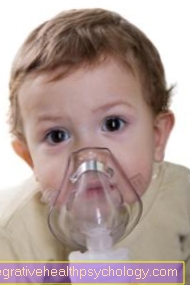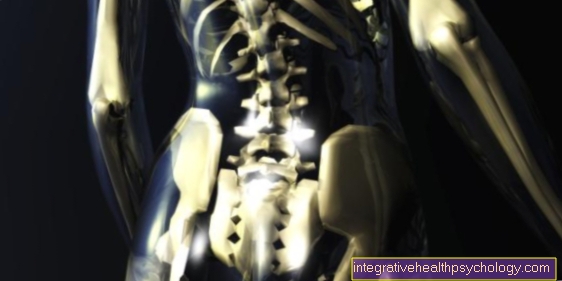Borderline syndrome
Synonyms
Emotionally unstable personality disorder, BPD, BPS, self-harm, parasuicidality
English: borderline
definition
The borderline disorder is a so-called Personality disorder of the "emotionally unstable" type. In this context, personality is understood to mean the characteristics and behavior of a person with which they react and will react to certain situations.
Emotional instability means that there is Borderline disorder there are difficulties in regulating the mood, the so-called “affect”. Small stimuli, be it external situations or one's own stressful thoughts, are often enough to trigger a very high level of excitement (positive or negative). In addition, after this arousal, it takes a very long time until the mood has returned to the level at which it was before the event or thought.

Is it curable?
In the case of mental illnesses, as with many somatic (i.e. physical) illnesses such as cancer, in technical jargon one does not speak of curability but of remission. The definition of remission in the case of a borderline personality disorder is measured by the fact that no symptoms typical of the disease have occurred for so many years.In the case of borderline disease, studies have now provided numerous indications that the disease often lasts for several years after the onset, but then remits in many patients, meaning that symptoms no longer occur.
This remission occurs after very different lengths of illness. For example, one study found a remission in just under 50% of the patients after 4 years, and another two years later, 70% of the patients were already in remission. A recent study showed remission in almost 90% of patients 10 years after diagnosis. Compared to many other mental illnesses, borderline personality disorder can speak of a possible curability in the broadest sense. It is noticeable, however, that many patients who have no symptoms of the disease for many years still have more problems in certain areas of everyday life than mentally healthy people.
In particular, social integration (stable partnerships, friendships, general contact with other people) is often worse in patients with borderline personality disorder than in others. However, studies indicate that social integration improves the more years have passed since remission (ie, the "healing"). Furthermore, so-called affective disorders occur significantly more frequently in patients who suffered from borderline disease in adolescence and early adulthood. These include, for example, depression or a manic-depressive illness. Anxiety and eating disorders as well as substance abuse also occur more frequently in remitted borderline patients than in the normal population.
Is It Hereditary?
Whether borderline disease is inheritable has been discussed and researched for many years. So far, however, there is no evidence that this is a disease that can actually be inherited. However, it appears that certain traits, such as a tendency towards emotional instability, are more likely to be seen in children of sick parents.
According to the current state of research, an outbreak of the disease only occurs if additional factors are added, such as certain living conditions or behavior. It has been shown that people with borderline disorders have experienced sexual abuse or violence more than average in their past.
First signs
The mental illness popularly known as borderline disorder is referred to in psychiatric jargon as an emotionally unstable personality disorder. This designation already contains some references to symptoms that can be present in borderline diseases. In particular, sick patients tend to be very moody and have uncontrollable emotional outbursts. They often act very impulsively and without first thinking about the possible consequences of their actions.
Typically, borderline patients often enter into interpersonal relationships, but in many cases these break up again quickly and are therefore very unstable. Sick people often switch quickly between very strong emotional clinging and clinging to their partner in order to then push them away and devalue them. Fear of loss, especially the fear of being abandoned, plays a major role in borderline illness.
Further possible signs of the presence of a borderline personality disorder can be a recurring feeling of inner emptiness and self-harming behavior up to (trying) to commit suicide. Often those affected describe that they have the feeling that they can feel themselves better again through cracks or other self-harming behavior. Other potentially damaging behaviors such as excessive gambling, drug use, sexual activity with constantly changing sexual partners or extreme eating behavior can also occur.
So-called comorbidities, i.e. additional illnesses, occur more frequently in patients with a borderline personality disorder than in mentally healthy patients. These include, for example, depression, addiction to drugs or alcohol, eating disorders and anxiety disorders.
Borderline in children
Borderline syndrome is not easy to recognize in children. During childhood or puberty, adolescents can already suffer from this disease and contrary to what one might assume, those affected do not just give themselves away Self harm. Often the disease also shows through rapidly changing moods. This is treacherous in that it is very difficult to achieve this emotional instability of harmless mood swings that are responsible for the difficult phase of the life puberty can be quite typical to delimit.
It is therefore not uncommon that changes in character typical of borderlines are not noticed first by parents or other family members, but by teachers or educators in kindergarten. This is plausible insofar as children in school or kindergarten have to be much more adapted than at home. If this causes them great problems due to emotional instability, it often becomes apparent more quickly outside the home environment due to a certain social incompetence. Overloading oneself and the uncontrollability of one's own emotions and impulses can also get through in children Bedwetting, sleep disorders and also eating disorder express.
Read more under our topic: Borderline in children
Borderline and relationships / partnership

The borderline syndrome has an extremely difficult effect interpersonal relationships out. It is almost the same here whether it is a partnership or a friendship. Most borderline patients find it very difficult to deal with other people because they have enormous difficulty assessing how they affect others or what others are feeling at the moment.
Dealing with the partner is particularly difficult. The reason for this is that, on the one hand, borderliners have a strong sense of self between Infatuation and self-loathing can fluctuate and on the other hand one excessive fear of being abandoned consists.
Typical for borderliners in a relationship is that they deny the beginning of the relationship Idealize partners excessively and elevate, however, it often only takes minor details such as being late for an appointment or other inattentiveness such as missing a promised call to make those concerned feel deeply offended. This usually has the consequence that the strong positive feelings that have just existed quickly turn into equally great ones as a result of an offense felt in this way Rejection turn over.
A borderline illness is therefore a very strenuous challenge for the partner and not infrequently a reason for separation.
Borderline in pregnancy
Women who suffer from borderline diseases can in principle become pregnant just as other women. However, especially during pregnancy, psychological / psychiatric treatment is extremely important for affected women in order to avoid possible harm to the unborn child. The tendency to abuse substances, for example the use of drugs or alcohol, can pose a great danger to the unborn child.
During and shortly after pregnancy, there are significant hormonal fluctuations which, even in healthy women, can often lead to mood swings and emotional outbursts. Patients with borderline disease tend to have strong and unstable feelings even when they are not pregnant, so that this can become significantly worse during and shortly after pregnancy. This is another reason for the need for regular care at this stage. It must also be discussed with the attending physician to what extent a pregnancy is possible with drug therapy, as some psychiatric drugs should not be taken during pregnancy, as they can harm the unborn child. However, discontinuation of the medication can lead to an increase in the symptoms that can occur with borderline illness. It is therefore very important for women who are affected to speak to the doctor in charge in detail, if possible before a planned pregnancy.
Borderline and loved ones
In principle, dealing with borderline victims can be very stressful. Relatives are often insecure because they cannot classify the impulsive outbursts of the sick and have to know how to deal with strong emotions.
Often there are abrupt changes in mood and associated changes in behavior on the part of those affected, which are difficult or even impossible to understand for relatives. Usually relatives of a borderline sufferer are much more relativized in order to compensate for the intense moods and thus ensure a constant pole of calm. However, it is important that worrying about the person concerned does not develop co-dependency in which one neglects one's own needs in order to take care of the borderliner and make him happy at one's own expense.
Some tips can be very helpful for relatives to keep in mind:
- Recognize and respect your own limits. Even if it may feel selfish at times, you don't have to be there for the person concerned 24 hours a day, but should also put your own needs in the foreground.
- Negative thoughts and feelings are also quite natural and should be allowed.
- Do not try to understand the impulsive behavior and mood changes of the other. Those who are not affected by borderline themselves will not be able to understand what the disease feels like, even as a relative.
- Do not force the person concerned to do anything or stigmatize him because of his illness. The desire for professional help, such as a psychologist, must come from the person concerned and cannot be imposed.
- Have a lot of patience. The disease can be treated, but will never be completely cured and will play a lifelong role in the lives of both the sick and their loved ones.
As a relative of a borderline patient, it is often difficult to enter into the emotional fluctuations and the inability to enter into adequate relationships, to accept them and to recognize them as an independent illness. It is particularly important that the relatives of a borderline patient seek help themselves and exchange ideas with other relatives in self-help groups or internet forums.
This helps enormously to alleviate your own pressure and fear a little. It is also very important not to make yourself feel guilty or think that you have failed yourself. In addition, as a relative of a borderline patient, one should try to convince the patient to go to a psychiatrist and a psychologist, since as a relative alone, one cannot master the situation and, above all, the patient's illness.
It can also be helpful here to have a family-patient conversation with the help of the psychotherapist in order to better understand the borderline patient and also to know how much you can do as a relative and where a limit must be set. In many borderline patients, in addition to emotional outbursts, self-harm often occurs. Here it is important to drive the patient to the emergency room of a hospital and get medical treatment there; under no circumstances should the relatives react hysterically or panic.
Even if it is very difficult, it is still important to try to act as rationally as possible without forgetting the necessary medical measures. Even if it is difficult as a relative of a borderline patient, it is important to try to act rationally and with a cool head, even when the patient attacks anger.
Read more on the topic: Borderline Syndrome - Family members should know that!
Borderline and sexuality
Borderline syndrome is also of great importance for them sexuality of the person concerned. Since the sick have a disturbed 'I-identity‘Have (in the sense of a lack of self-perception), they don't really know themselves or their sexual preferences. Borderliners often have difficulty choosing between 'You' and ,I‘, So that it becomes the phenomenon of the so-called 'Projective identification‘Is coming. Put simply, this means that a borderline sick person can tend to take over the other person. In relation to sexuality, this means that he simply takes over the sexual fantasies of his counterpart / partner without really knowing whether he feels aroused or repelled by them.
Borderliners also tend to use sexuality as a kind of outlet. The instincts that in the mentally healthy are caused by the intact 'I‘(A component of personality, described for the first time by Freud) are filtered and controlled, are simply acted out in borderline patients in the absence of this structure. So it is not surprising that the sick very often get through risky sexual practices and frequently changing sexual partners distinguish. There is consequently an increased risk for sexually transmitted infectious diseases, such as HIV because those affected often do not protect themselves adequately during spontaneous sex with casual acquaintances or strangers.
Epidemiology

Borderline disorder is a disorder that is more common in young people. The first symptoms usually appear in childhood and develop with increasing age.
As a rule, the full picture (with fear, depression, suicidality, etc.) develops between the ages of 16 and 18. Long-term studies have shown that the symptoms of a borderline disorder decrease significantly with age (between 40 and 50 years of age).
Approx. 70-75% of those affected are women, although it should be borne in mind that men with this disorder are likely to visit the doctor less often and are more likely to be in prisons because of possible criminal offenses due to aggression.
The probability of developing a borderline disorder in the course of life is 1-1.5% in the general population.
causes
The causes that make a person fall ill with borderline syndrome are not yet clearly clarified. But since the disease is among the Personality disorders is counted, it stands to reason that the cause / s are often in the time of personality formation - i.e. Childhood and youth - lie. Of course, some can genetic predisposition favor the development of a borderline syndrome. Especially when in the First degree kinship known mental illnesses exists increased risk. It will always be three components which make borderline syndrome likely:
First, the loss of a parent (e.g. through separation) or other unhappy childhood experiences such as emotional coldness in dealing with the child. If parents cannot empathize with their children, this can have an impact on development as an early negative relationship experience.
The second component, which can injure a child or a young person in such a way that borderline illness can result non-physical abuse. These include injuries in the emotional or verbal sense, i.e. permanent disregard or neglect of the child, but also constant “getting ready” or insulting them.
The third component are physical abusen as well as sexual abuse. The figures for how many borderlines were exposed to which different traumas in their childhood vary. According to some surveys, a full 50% of borderline patients were exposed to physical violence in childhood. 70% of those affected were sexually abused, of which half of these cases was abuse by a family member. 25% of borderliners even had an incestuous relationship with one of their parents.
You can find further information under our topic: Causes of the Borderline Syndorm
Comorbidity
A number of other psychiatric disorders can co-exist with borderline disorder. In various clinical studies it was found that almost all patients met the criteria at least once in their lifetime depression fulfill. Almost 90% met the criteria of one Anxiety disorder and more than half had one eating disorder or substance abuse.
The chances of developing another personality disorder in addition to the emotionally unstable one were also quite high.
Features / symptoms
For borderliners are at least five of the following nine characteristics:
Those affected can hardly bear to be alone, they want to Avoid breakups at all costs. This means that in all relationships (whether with parents, friends or partner) feel enormous fears, be it just showing up late for an appointment or forgetting a promised call. Sometimes those affected become “preventively” failing for fear of being injured, as if to forestall an attack by others.
Relationships that borderliners lead to other people are enormous intense but also just as unstable. Hate and love alternate very often, i.e. the partner is initially idealized in an exaggerated manner. A little later, however, it only takes little things to change the world of emotions.
Those affected also have a disturbed identity, in the sense of distorted to wrong self-perception. You don't really know yourself, neither your strengths / weaknesses nor what calms you down or stimulates you.
People who suffer from borderline syndrome are very impulsive. You have difficulties correctly assessing losses and risks. This manifests itself in everyday life e.g. through risky sexual practices, drug and excessive alcohol consumption, excessive spending, "binge eating" or very dangerous sports.
Borderliners are also strikingly unbalanced, irritable and fluctuating very much in their moods. Sometimes one wrong word is enough for them and there is a violent outburst of emotion.
You feel often emotionless and bored.
This also explains another symptom, namely the Self-harming tendency. Borderline patients suffer so much from themselves or their disorder and the aforementioned numbness that they e.g. sticking out a still-lit cigarette on your skin, hitting yourself or scratching yourself with razor blades to feel yourself again. However, the emotional emptiness increases the borderliners' perception that only other people make their own life meaningful.
Borderliners also have one in this respect lack of impulse controlso that they cannot always suppress strong anger.
- Affected people have phases in which they distrust everyone and yourself withdraw strongly.
fatigue
Fatigue is an extremely unspecific symptom, it can occur in almost all mental and physical illnesses and can also occur in complete health. It is not an indicative symptom of borderline disease. Rather, a feeling of inner emptiness is typical and is often described by affected patients. Of course, tiredness can also occur in someone with a borderline personality disorder.
Cracks
When a borderline disorder is mentioned, self-harm is probably the first thing most people associate with this disease. The most common variant of self-harm is injuring the skin, known as scratching. The injuries are often inflicted with razor blades or other sharp objects, often on the inside of the forearm.
First of all, the injuries can be recognized as numerous, relatively straight, bloody scratches; depending on how deep the injuries are, often scars remain. This is then shown in the form of numerous white lines that are mostly arranged across. However, these injuries can also occur on any other part of the body. Borderline patients often describe that they feel better again through such self-harm, that they can dispel the often existing inner emptiness better or that they reduce internal states of tension by scratching.
lying
Borderline patients are said to have a tendency to lie. This fits into the overall concept that those affected tend to manipulate their environment in order to achieve the goal they have set themselves. In order to maintain a relationship, borderline patients often use lies in order to avoid the abandonment that they often fear so much. When you talk about lies and manipulation here, it sounds like something very deliberate at first. Quite often, however, there is a pronounced fear behind these behaviors, which leads to the use of such means.
therapy

Therapy with a psychologist or psychiatrist is absolutely necessary in the case of borderline illness. Unfortunately, it does not 'heal' the affected person in a short time (there is also no drug against the borderline syndrome, only individual symptoms / phases of suffering such as depression or similar can be alleviated by drugs).
Psychotherapy is the method of choice in this context, but often only brings lasting improvement for those affected after a long time, when the causes and triggers of the disease have been identified and worked through. In the large area of psychotherapy there are many different types of therapy, several of which are also suitable for borderline illness:
A therapy of choice in the case of borderline is behavior therapy. Her main priority is to lead the patient to the point where he learns to understand what is causing his complaints. Specifically, this means that it is made clear to the patient that behavior is determined by the recognition and assessment of things and situations. So if e.g. reacts completely hysterically and with immeasurable fear to a non-poisonous snake, it stems from an exaggerated assessment of the snake's danger. The central theme of behavior therapy is that the person concerned confronts their fears or situations that they are trying to avoid (often only in simulated moments) and that the wrong assessment is forgotten. In this way, the person concerned gains the self-control he needs in order to be able to face even these unpleasant situations.
People suffering from borderline syndrome can also be helped by counseling psychotherapy according to C. Rogers. Here, fewer conflicts from childhood are dealt with, but more everyday situations and problems of those affected are brought into focus. The basic assumption of this form of therapy is that a great source of everyday suffering in these people's lives comes from the fact that their wishful thinking about themselves and the desired appearance / behavior (so-called self-concept) with unwanted behavior patterns in certain situations (e.g. enormous excitement and embarrassment, if you get to know a celebrity) collides or does not match. The aim here is to make it clear to these people that a so-called incongruence (i.e. a difference) between self-concept and actual occurrence is completely normal and not pathological in some situations.
Read more: Therapy and help for children and adolescents with behavioral problems
Analytical psychotherapy is a very popular form of therapy. Like classical psychoanalysis, it is based on the assumptions of the famous Sigmund Freud. The basic idea of analytical psychotherapy is that conflicts experienced in childhood are not fully processed and can lead to problems and behavioral problems in adulthood. Here the childhood development is traced and illuminated very precisely, with the aim of dealing with unresolved conflicts. In contrast to this, however, classical psychoanalysis assumes that the behavior patterns learned in childhood for interpersonal relationships and also for conflict management can be stored in the subconscious and can no longer be modified in adulthood.
Another possible form of therapy is psychotherapy based on depth psychology. It is also based on the assumptions of psychoanalysis, but focuses not so much on the conflicts from childhood but on current problems and changes in behavior in everyday life.
Read more on the topic: Borderline therapy
Medication
The most important pillar in the treatment of borderline personality disorder is psychotherapy. However, additional drug treatment is also an option and is used for most of the sick. However, there is not just one drug for treating borderline disease that can completely suppress symptoms. However, there are several drug options. Which of these is most suitable depends heavily on which symptoms are in the foreground in the context of the disease for the individual affected.
In Germany, no drugs are officially approved for the treatment of borderline disorders. This does not necessarily mean that there are no drugs that can help, but rather that studies on the positive effect of drug therapy are not yet sufficient. Since there are no officially approved drugs, the use of drugs in the disease is referred to as off-label use. For the drug treatment of borderline personality disorder over a longer period of time, psychotropic drugs from the group of mood stabilizers are used in particular. These include active ingredients such as Lamotrigine, topiramate, and valproate / valproic acid.
Also the antipsychotic Aripiprazole is said to be effective in the treatment of borderline disease. Antidepressants from the group of so-called SSRIs were used more frequently in the past, but studies have not found sufficient effectiveness unless there is also a depressive component so that this group of drugs should no longer be used. It should be emphasized, however, that all psychotropic drugs listed here - if at all - should only be used in combination with disorder-specific psychotherapy in order to achieve satisfactory treatment results. In addition, the success of the treatment is very different from patient to patient, so that in some cases different treatment concepts have to be tried out. However, psychotherapy is still the top priority in the treatment of borderline personality disorder.
Diagnosis
Any diagnosis (so does the diagnosis) Borderline that is set in this country, if you want to do it professionally and not simply from the gut, must be "encrypted". This means that there are systems in which all diseases known to medicine are more or less well recorded. So a doctor can't just go and distribute diagnoses unless certain criteria are met that the encryption system requires. If the criteria are not met, the diagnosis of borderline cannot be made.
In psychiatry in Germany we work with two systems. One is the so-called ICD-10 system (International Classification of Diseases, according to WHO). This is the standard system for encryption and diagnosis in hospitals. This system is supported by the donors (the health insurance companies) required. Critics sometimes see the ICD - 10 as too imprecise in describing diseases such as borderline.
The research uses the system of the DSM - IV (Diagnostic and statistical manual of mental disorders). Here the descriptions of the symptoms of the disease are actually more precise. In order to be able to make the diagnosis, precisely defined criteria must be met (see also mental disorder).
Diagnostic criteria for emotionally unstable personality disorder according to ICD - 10 criteria:
A.) In order to be able to diagnose a borderline disorder, at least 3 of the following characteristics or behaviors must be present:
- Clear tendency to act unexpectedly and without considering the consequences.
- clear tendency to quarrels and conflicts with others, especially when impulsive actions are prevented or reprimanded.
- Propensity for outbursts of anger and violence with inability to control explosive behavior.
- Difficulty maintaining actions that are not immediately rewarded.
- Fickle and unpredictable mood.
B.) In addition, at least two of the following properties and behaviors must be present for the borderline diagnosis:
- Disturbances and uncertainty regarding self-image, goals and "inner preferences"
- Tendency to get involved in intense but unstable relationships, often resulting in emotional crises.
- Excessive efforts to avoid abandonment.
- Repeated threats or acts of self-harm.
- Persistent feeling of emptiness
The DSM-IV diagnostic criteria for borderline personality disorder:
In order to be able to diagnose a borderline disorder, at least 5 of the following characteristics or behaviors must be present:
- desperate effort to prevent real or imaginary solitude.
A pattern of unstable and interpersonal relationships that is characterized by an alternation between extreme idealization and devaluation - Identity disorder: a marked and persistent instability of self-image or feeling for oneself.
- Impulsiveness in at least two potentially self-harming areas (e.g. spending money, substance abuse, reckless driving, binge eating).
- Recurring suicide threats, suicide suggestions or attempts, or self-harming behavior.
- Affective instability, which is characterized by a pronounced orientation towards the current mood: e.g. severe episodic depression, irritability, or anxiety.
- Chronic feeling of emptiness.
- Inappropriately strong anger, or having difficulty controlling anger or anger (e.g., frequent outbursts of anger, persistent anger, repeated fights).
- Temporary, stress-related paranoid ideas or severe dissociative symptoms.





























